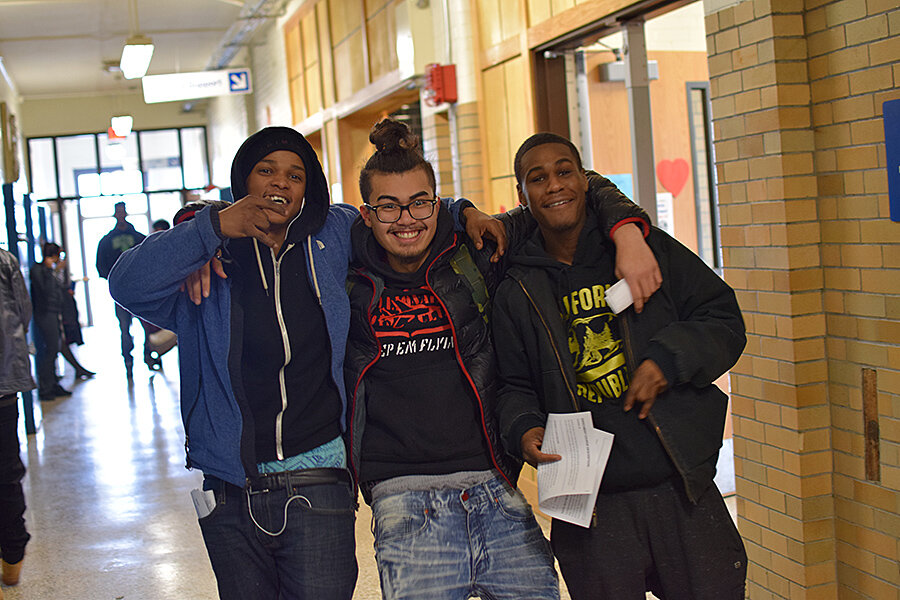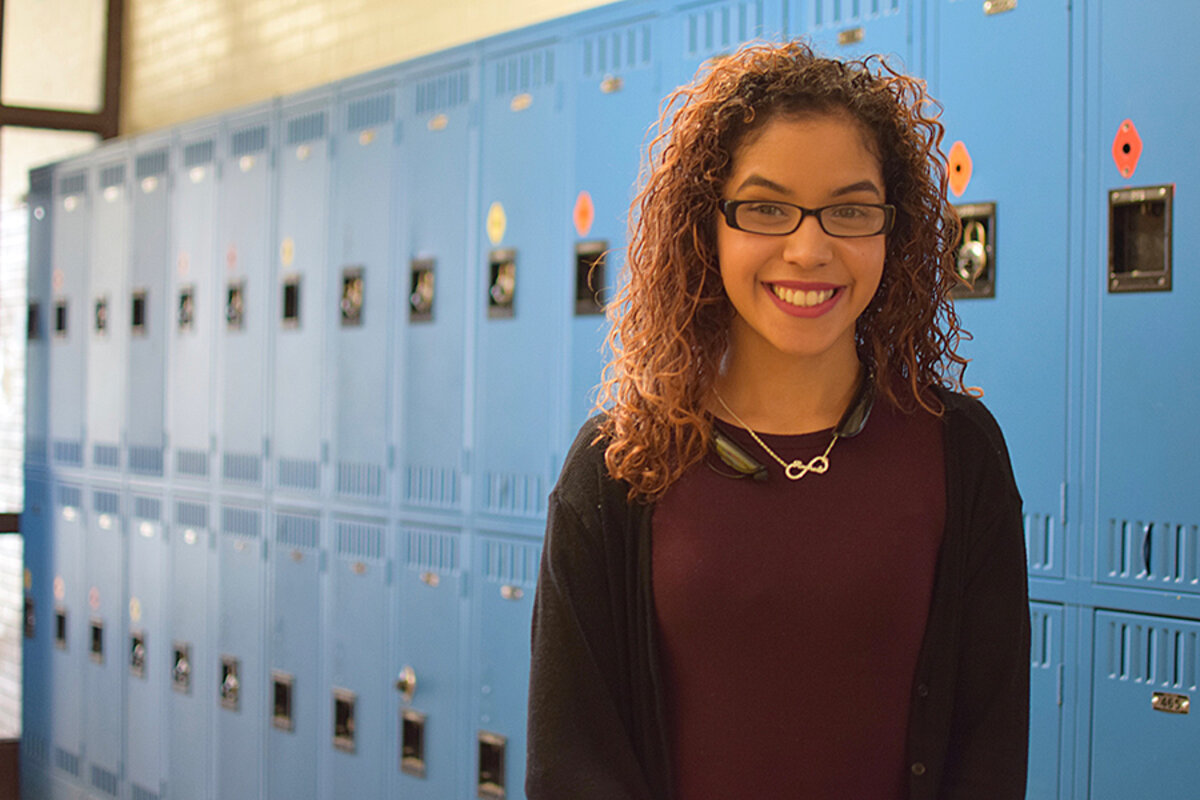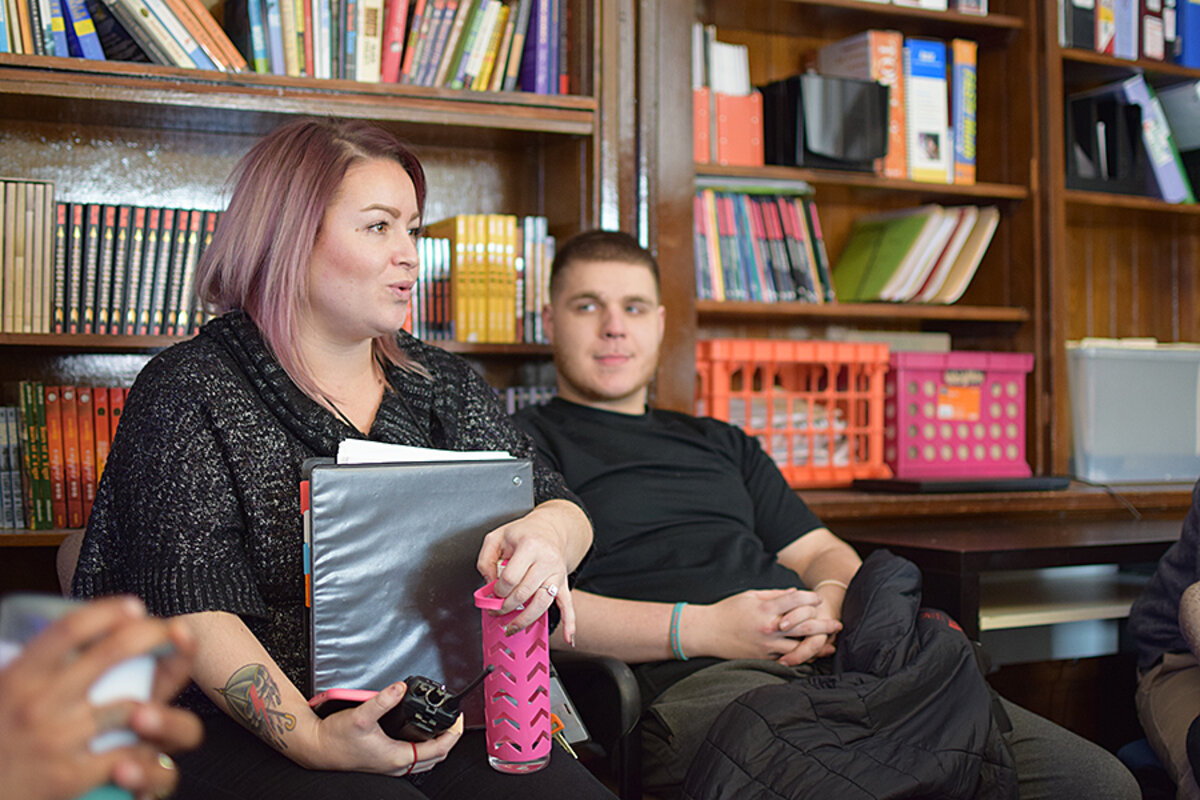'Last Chance' schools prove to be best chance for struggling students
Loading...
At Boston Day and Evening Academy, there are no such things as freshmen, F's, or detention.
Sixteen-year-olds share classrooms with 20-somethings, students earn diplomas at their own pace, and if anyone has a problem with a peer, they’re encouraged to talk about it like adults. It is features like these that have helped former high school dropouts such as Rocheli Burgos – and other students who have struggled in school – get a second chance at earning a diploma.
After giving birth to her son in 2011, Ms. Burgos dropped out of her old school when counselors told her that she didn’t have enough credits to pass ninth grade. Burgos then discovered this alternative high school in Boston’s Roxbury neighborhood, where students aren’t placed in classes by age or transcript, but by what they know. She was 17, battling severe depression and dealing with a fallout with her family that would soon leave her homeless.
At the Boston Day and Evening Academy (BDEA), Burgos found a curriculum that made it possible to take breaks and start where she left off, so she wouldn’t have to repeat an entire class when her son’s long hospital stays for chronic asthma meant missing a month or two of school. She met teachers who checked in with her on the weekends to make sure she was doing okay – and not just academically. Soon she began to thrive.
“This school, they just pick up your spirit,” Burgos says. “They took out all the negativity out of me when I felt like I wanted to give up half the time.”
While BDEA’s approach to education may once have been a radical departure from the norm, educators say it’s gaining in popularity and becoming a role model for others. For one, its strategies work: According to school administrators, 65 percent of its students graduate from BDEA or get a general equivalency degree (GED), 70 percent of its graduates go on to college, and the school has one of the lowest suspension rates in Massachusetts, despite several gang affiliations among its students.
Alternative schools can vary widely, and some have been criticized for warehousing difficult cases and using harsh discipline. But a subset of alternative schools has long embraced more progressive models of education. More high schools, and some entire states, are borrowing ideas that “last-chance” schools like BDEA have been using for decades – practices such as competency-based education, attention to students’ social and emotional well-being and a “restorative justice” approach to school discipline.
“I think what people are coming to realize is that [these practices] apply to all students,” says Leah Hamilton, education director of the Boston-based Barr Foundation. (The Barr Foundation is a funder of The Hechinger Report.)
“All students need to be deeply known by the adults that are working with them to support their learning,” she says. “All students need to have transparency about where they are in their progress and what they need to do to meet graduation standards.”
Self-paced learning
As part of BDEA’s competency-based approach, all new students take a trimester-long course in which they study math, English language arts, and science together. Teachers determine how much the students know about each subject, on a scale from “highly competent” to “not yet competent.” They are then placed in courses that match their skill levels – regardless of age or whatever letter grades they earned at their previous schools.
If a student struggles in reading but is good at algebra, for example, he or she may end up in an introductory literature class while taking advanced math. Once students have demonstrated competency through a written or project-based assessment, they can move on to the next course in that subject area at their own pace.
Flexibility in curriculum for students who are all over the place academically is a key component in successful alternative schools, Ms. Hamilton says, because of the populations they tend to serve.
According to a National Center for Education Statistics report, children with behavioral problems are the most common target group for alternative school programs, which served more than 575,000 students in 2013 (the most recent year for which data is available). The schools also serve students who have academic difficulties, have dropped out of high school, or are at risk of doing so for other reasons, including pregnancy, homelessness, and abuse.
Of the 405 students at BDEA, who range in age from 16 to 23, almost all are economically disadvantaged. Half self-identify as having a mental illness and about a third have experienced significant trauma during childhood, according to information provided by the school.
“Alternative schools opened to say, ‘Hey, not all students are the same,’” says JoEllen Lynch, executive director of Springpoint, an organization in New York that specializes in redesigning schools.
Ms. Lynch has spent the last 35 years as an advocate for reforming the traditional school experience to include some of the practices she learned during the first part of her career in alternative education. Alternative schools are generally smaller, more personalized, and have always operated by putting students’ needs first, she says.
“The large, factory-model high school will just keep leaving them behind,” Lynch says. “They just keep failing them.”
But the old factory model is becoming less common as alternative versions like BDEA’s catch on. New Hampshire and Vermont are among more than a dozen states that have passed laws introducing some form of competency-based education. In some places, all schools are required to allow students to pass a class by showing mastery, rather than by adding up their seat time.
For students such as Burgos, it means not feeling pressured by seeing peers advancing more quickly.
“If you’re in ninth grade or whatever in a regular high school and you see other people passing you...you would feel like, ‘Dang. Either I’m not smart enough to go up those grades,’ or ‘I won’t be able to pass,’” says Burgos.
Relationships make the difference
Alyson Sullivan is a community field coordinator at BDEA whose role in the Student Support office involves more than academic counseling and discipline. On one recent Monday morning, she counseled one student who was in an abusive relationship and advised another whose family was in danger of losing their house after his father’s recent death.
“If you talk to our students, nine times out of 10 if you ask them, ‘Well, why was it different here? Why did you make it here and you couldn’t at your old school?’, they say the relationships they have with staff,” says Ms. Sullivan. “Just really having those genuine and authentic relationships with our students makes us different.”
Recent graduate Masiah Jones can attest to that. While attending her old high school, she was working 50 hours a week at a pizza shop to help provide for her family. Her grades slipped, but teachers didn’t seem to understand why, she says, and sometimes she felt judged.
A few months before Ms. Jones graduated from BDEA last December, her mother could no longer afford to let her live at home. So some BDEA staff members took turns letting her stay with them.
“I wouldn’t have had that anywhere else,” the teen explains. “I wouldn’t expect a teacher to do that for me.”
Burgos, too, has relied on staff support outside of the classroom. Though she was once too embarrassed to tell her teachers and advisers that she was living in a shelter, she’s now enlisted their help in her search for permanent housing.
An approach focused on the needs of the “whole child” and on students’ social and emotional development is a hallmark of alternative education, says Ephraim Weisstein, executive director of the nonprofit Diploma Plus, a network of competency-based alternative schools.
“They have to have it,” he said. “Otherwise there would be no way that this would work given the students who come to them and their needs.”
This approach, too, has been gaining traction in mainstream education. School districts from Anchorage to Atlanta have placed renewed attention on socio-emotional learning, with Boston Public Schools creating a new administrative position dedicated to it in 2015.
‘Restoring’ not suspending
BDEA favors conflict mediation over zero-tolerance policies as a way to prepare young people to handle themselves in school and beyond. When students disagree, staff guide them through mediated conversations to address their issues. If a problem escalates in a public place and disrupts learning, then the students must apologize to their peers during a school assembly. Suspensions are reserved for violence or bringing weapons to school.
Studies have shown that this “restorative justice” approach, as this method of discipline is often called, can have two benefits. It often decreases suspensions and expulsions, which are prone to racial disparities. And, on the flip side, it can improve school climate and even increase graduation rates. Such results have led more schools to reject zero tolerance in favor of restorative justice, and models like BDEA’s have proven it can work in schools.
Founded in 1995, BDEA has been using restorative justice since before the practice earned its name, says Alison Hramiec, the head of the school. She tells students that they’re not expected to be perfect – that they’re going to make mistakes, and that sometimes those mistakes will be a reflection of the environment in which they live.
“But we’re not going to kick you out for that. We’re not going to say you failed because of that. We’re going to say what’s more important is that you learn from that and that we see continual growth,” she says.
Despite rival gang affiliations among the student body, there has been only one physical altercation between students in the last two years, according to school officials. The school’s suspension rate is among the lowest in the state.
“They really respect the space because we respect them,” Sullivan says. “We treat them like people and like young adults.”
As this approach gains steam, some districts trace its implementation back to alternative schools. In eastern Pennsylvania, the affiliated nonprofits Community Service Foundation and Buxmont Academy, which run six alternative education programs for at-risk youth, among other programs, have been using restorative practices since the early 2000s. They’ve since trained district leaders in surrounding areas on moving from a zero tolerance to a restorative approach.
One reason restorative justice works at BDEA, Ms. Hramiec explains, is that students who are in classes that match their academic abilities are not bored or frustrated in the classroom. The emphasis on students’ social and emotional needs also makes a difference, as the student support team is trained to identify outside stress factors before they escalate.
Mr. Weisstein says that although some schools of 2,000 or so students are now trying strategies similar to BDEA’s, there’s a reason why more haven’t latched on to its personalized approach: It’s “frankly too much of a headache,” due to student-body size and scheduling, to comfortably reach everyone.
Yet, at BDEA, the strategies worked for Burgos. She graduated last September and started working part time at the school as a teaching assistant in the fall.
She’s doing it to gain experience for a future career in teaching, she says. But she also wants to give back to the school that ultimately helped her to “grow up” and – with high school diploma in hand – feels as though she can finally start a better life for herself and her son.
This story was produced by The Hechinger Report, a nonprofit, independent news organization focused on inequality and innovation in education. Read more about high school reform.










